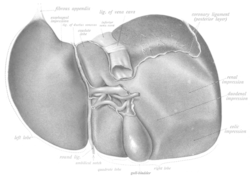Lobe (anatomy)
In anatomy, a lobe is a clear anatomical division or extension[1] of an organ (as seen for example in the brain, lung, liver, or kidney) that can be determined without the use of a microscope at the gross anatomy level. This is in contrast to the much smaller lobule, which is a clear division only visible under the microscope.[2]
| Lobes | |
|---|---|
 Visceral surface of the liver showing the four lobes | |
| Identifiers | |
| TA | A13.1.02.002 |
| FMA | 45728 |
| Anatomical terminology | |
Interlobar ducts connect lobes and interlobular ducts connect lobules.
Examples of lobes
- The four main lobes of the brain
- the frontal lobe
- the parietal lobe
- the occipital lobe
- the temporal lobe
- The three lobes of the human cerebellum
- the flocculonodular lobe
- the anterior lobe
- the posterior lobe
- The two lobes of the thymus
- The two and three lobes of the lungs
- Left lung: superior and inferior
- Right lung: superior, middle, and inferior
- The four lobes of the liver
- Left lobe of liver
- Right lobe of liver
- Quadrate lobe of liver
- Caudate lobe of liver
- The renal lobes of the kidney
Examples of lobules

Lobules of the mammary glands.
- the cortical lobules of the kidney
- the testicular lobules of the testis
- the lobules of the mammary gland
- the pulmonary lobules of the lung
- the lobules of the thymus
gollark: https://bitcoin.org/bitcoin.pdf
gollark: I know a *bit*. There is the whitepaper you can look at.
gollark: Folding@Home doesn't recompute everything on every single computer. BitTorrent also does not redo everything on every computer. This is an inaccurate comparison.
gollark: They don't want people using it because they can't ruthlessly monetize it and/or use their users for QA.
gollark: > With the LTSC servicing model, customers can delay receiving feature updates and instead only receive monthly quality updates on devices. Features from Windows 10 that could be updated with new functionality, including Cortana, Edge, and all in-box Universal Windows apps, are also not included. Feature updates are offered in new LTSC releases every 2–3 years instead of every 6 months, and organizations can choose to install them as in-place upgrades or even skip releases over a 10-year life cycle. Microsoft is committed to providing bug fixes and security patches for each LTSC release during this 10 year period.
References
- lobe Archived 2017-09-27 at the Wayback Machine at eMedicine Dictionary
- SIU SOM Histology GI
This article is issued from Wikipedia. The text is licensed under Creative Commons - Attribution - Sharealike. Additional terms may apply for the media files.